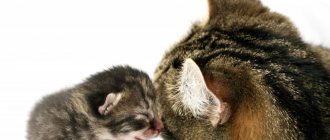A little about the dream itself
Science has been studying cat dreams since the middle of the last century. Judging by the data from devices connected to sleeping purrs, they are in many ways similar to their owners. Scientific research has shown that even when a cat is resting, the brain continues to work actively, almost the same as during wakefulness. Not a single animal can refuse sleep, otherwise it will be impossible to restore energy expenditure.
Cats sleep 15-18 hours a day.
The following sleep phases are distinguished:
- Superficial (fast). At this time, the body is just preparing for rest. But any irritant can provoke activity. The duration of the period is 10-15 minutes. At the same time, muscle tone is preserved, the animal remains tense.
- Deep (slow). During this period, the muscles relax, the body of the purr becomes limp. The eyes are closed, the movement of the eyeballs is noticeable. This is a sign that the animal is dreaming.
Cat sleep is in many ways similar to human sleep.
When an external stimulus appears, for example, noise, a cat that is in a deep phase will wake up, but it will not be able to immediately get up and run. Awakening happens slowly. Usually at this time the cats stretch and begin to wash themselves.
The French scientist Michel Jouvet managed to uncover the secret of cat dreams during an experiment conducted in 1979. When the body sleeps, the ability of the muscles to move is turned off by the brain in its special department. Scientists invaded this program and stopped this shutdown of movements in the experimental cat. As a result, the purr literally became a sleepwalker. During the deep phase the cat was motionless, but during the fast phase he moved, hunting for someone, not paying attention to the real mouse offered. This suggests that cats are capable of experiencing joy, sadness, anxiety and other emotions in their dreams.
You should respect your pet's rest. Just like a person, when a furry suddenly awakens, his heartbeat quickens and he gets scared.
The love of sleep is in cats' genes
Cats sleep about 16 hours a day and the older the animal gets, the more it sleeps. Adult cats can sleep up to 20 hours a day. Sleeping habits are directly related to feline physiology. In the wild, cats must hunt to avoid starvation. Chasing and fighting with prey burns a huge amount of energy and therefore the animal sleeps between such runs in order to save energy valuable for survival. This energy will be wasted during the hunt. The cat sleeps about three-quarters of the time, and this is really only a light sleep, which allows you to save energy and give your muscles a rest, but despite this, the animal seems to be in a waiting mode to wake up at any moment. The cat's ears vibrate and rotate in the direction of sound sources, while the eyes are half-open. This state can be compared to a state of rest or light sleep. Cats can sleep in any position.
Do cats dream?
As a result of observations and research, scientists have come to the conclusion that cats really dream. But what exactly they dream about remains a mystery. The assumptions can be anything, from hunting mice to playing with other animals.
The age of the animal influences dreams. Kittens under the age of 1 month are deprived of dreams, and they sleep much less than adult pets - about 12 hours. The deep phase occurs in older cats. Full-fledged dreams appear in purring cats that have reached the age of three months. Adult pets doze more than sleep soundly. At this time, they are able to react sensitively to external stimuli and do not dream.
It is impossible to say what kind of picture the purrs see - color or black and white. Moreover, cats’ vision differs from that of humans, and they see the world somewhat differently. It is believed that active, emotional pets can see colorful dreams.
Kittens under the age of 1 month are deprived of dreams. Adult pets often doze. In the deep phase of sleep, the cat is motionless.
Do cats dream?
Scientists have always wondered whether cats dream. Much research and experimentation has been carried out to measure the brain activity of our little brothers and their general state during sleep and wakefulness.
It was interesting that in a dream the same impulses emanate from cats as during wakefulness. Their brains continue to work actively. That is, judging by the high brain activity, it seems that meowing pets are not sleeping at all. In fact, this opinion is wrong. Every living creature is designed in such a way that it simply needs sound sleep for the normal functioning of the whole organism.
The fewer brain convolutions, the less need for such rest arises. The deep sleep phase is also called the REM phase. Scientists have found that fish do not have such phases. In birds they last a couple of minutes. In rats, the REM phase lasts half an hour a day. In humans, generally from one to two hours a day. And only the cat had the longest stay in this sleep phase. This takes about three hours a day.
What such dreams are like in general is still unknown to anyone. But scientists have come to the same conclusion that a person without such sleep begins to suffer from mental disorders.
Anyone can make sure that a cat dreams. You just have to take a close look at your pet while he is resting. At the same time, the animal’s eyes seem to be closed, but under the eyelids their constant movement is observed. Of course, no one will probably ever know what kind of dreams cats have. One can only guess and fantasize about this. If a cat twitches its paw, moves its ears, whiskers or tail in its sleep, most likely pictures from its everyday life are floating before its eyes. At the same time, the body is completely relaxed.
It has also been noted that animals living in different environments have different ways of being in the deep phase. Barn cats, for example, sleep less, because they need to constantly check their territory and chase mice. And well-groomed pets, who do not need anything, often indulge in the two most important activities in their lives - eating all kinds of delicious food and sleeping.
A cat's sleep also directly depends on its age. Small kittens, for example, sleep 12 hours a day. And without dreams. Already after 1 month of life, they begin the slow-wave sleep phase, and at three months, a kitten’s sleep becomes similar to the sleep of an adult cat.
These animals most often do not suffer from sleep problems. But if for some reason the animal was deprived of deep sleep, it becomes aggressive and irritable. If your pet sleeps longer than usual, there is some good reason for this. Perhaps the room is very hot, the cat is pregnant, or moving to a new place has caused stress in the animal. But if all these reasons are not present, and the pet sleeps most of the time, perhaps some disease is bothering him. You should definitely take a closer look at the animal and, if necessary, seek help from a good veterinarian.
Similar articles:
- Cats are healers
- Lifespan of cats
- Why are people afraid of black cats?
- How to get rid of cat smell
- Why cats love boxes
- How to choose a kitten
Do cats have nightmares?
You can often notice that a sleeping pet twitches its tail and paws, hisses, and scratches an invisible victim. This behavior makes it possible to claim that the cat sees something to which it reacts negatively. Apparently the animal is having a nightmare.
If your furry dog often becomes restless while sleeping, you should contact a veterinary clinic and have it examined. Sometimes this behavior can be caused by head injuries or the development of tumors.
Cat sleep is in many ways similar to human sleep. And the socialization of animals made them even more similar to people. The area of sleep still remains unknown in many aspects, but the fact that cats dream is beyond doubt.
Recommended Posts
Standard height and weight of the Cane Corso breed by month
Weight of a puppy and an adult Labrador by month
Weight and height of a German Shepherd puppy by month
TOP 40 best hunting dog breeds with names, descriptions and photos
38 best dog breeds for apartments according to reviews from breeders and owners
Why cats can’t fish and the dangers of having too much of it in their diet
How and when do cats sleep?
If a cat does not sleep at the required hours, being in a relaxed state, but looks for a secret place for dreams, it means that she is not so comfortable next to her owner. Normally, a cat would rather prefer the master's bed than the corner under the sofa. An animal that completely trusts its owner easily falls asleep on his lap, turning over on its back and putting all four paws in front of it.
When a cat is 9 years old, she slept for about 6 years of that time.
The place to sleep will most often be located at some elevation, and it will be something soft and warm. The cat will stomp on the chosen bed, stretch, relaxing every muscle, and very quickly falls asleep.
There are also originals among cats, which seem to be smeared with honey on the owner’s laptop, important documents on the table or freshly ironed linen.
Cats sleeping problems
In cases where a cat, not exceeding its usual sleep norm, suddenly begins to constantly doze off and look drowsy, it is first determined whether this is due to pregnancy or weather conditions (excessive heat or extreme cold). If a cat spends more than 18 hours sleeping, then such drowsiness may come from some kind of disease. A cat's sleeping position can help identify the problem: a frozen posture like a sphinx or attempts to spread its limbs that are unusual for an animal indicate hyperthermia. Also, an excessive amount of sleep is an indicator of the onset of heart problems.
Other sleep disorders include insomnia. Stress caused by moving, the arrival of a new family member, or an influx of guests may be to blame here. Sometimes cats have seizures in their sleep - it’s better to film any oddities and then show it and the animal to a veterinarian.
Scientists have penetrated the dreams of cats and dogs
Author Irina Shlionskaya
08.10.2014 10:00
Science » Good to know
Undoubtedly, all animals have consciousness, although not the same as that of humans. For a long time, scientists argued about whether our little brothers can see dreams. But if you can simply ask a person what he dreamed, then how can you find out about the dreams of a cat or a dog? Meanwhile, according to some signs, the content of a dream can be determined, experts say.
Crazy news: the whole truth about cats!
The first observations on this topic are described in the treatise of the famous ancient Greek thinker Aristotle “On Sleep and Wakefulness.” “It has been observed that almost all animals, whether aquatic, aerial or terrestrial, quite obviously fall into a state of sleep,” he wrote. In another of his works, The History of Animals, Aristotle argued that if a dog barks in a dream, it means that it is dreaming.
According to University of Southern California (Los Angeles) graduate student Jason Goldman, who studies the evolutionary psychology of humans and animals, there are two ways to peer into the consciousness of living beings during sleep. The first is observing the behavior of a sleeping animal in various phases of the “sleep” cycle. The second is to compare brain function during sleep in humans and animals.
According to research, the entire sleep period is divided into phases that differ in different levels of brain activity. The phase with relatively reduced activity is called “slow-wave sleep.” This is usually followed by the so-called “fast” phase, when brain activity is almost the same as during wakefulness. It is characterized by rapid eye movements, which is why it is also called the REM phase (from English rapid eye movement). In the “fast” phase, the spinal cord sends impulses that “inhibit” the nervous system, as a result our body becomes “paralyzed” and we are unable to move, speak or scream.
Why does a cat dream at night - features of deep rest
This sleep phase is accompanied by a change in the nature of the pet’s brain activity:
- increased body temperature;
- mild tachycardia;
- slight increase in pressure.
This is the answer to the question “why does a cat dream at night?” Despite these obvious similarities to human sleep, deep rest in a cat is somewhat different. Their brain doesn't sleep.
Why can cats defend themselves even when they are dreaming at night? It's all about instincts, in particular self-preservation. It allows the animal to react to sudden changes and defend itself earlier than a human.
Sleepwalking cats
Manifestations of sleepwalking occur not only among people, but also among animals. There is a lot of evidence that cats can, for example, wander around at night with their eyes closed and even make sounds while doing so.
Just imagine this picture: at 2 o’clock in the morning a cat approaches the head of the bed with its eyes closed and does not respond to any of your counter questions. Goosebumps involuntarily run through the body.
According to scientists from the University of Lyon, who conducted detailed neurophysiological studies, cats most often dream about hunting and exploring territory. In this case, aggressive behavior predominates, and feelings of fear are much less common.
Why do cats rest so much?
This is inherent in them by nature. A predator, which a cat is, is characterized not by endurance, but by intense work in a short period of time. First, the cat looks out for prey, then carefully creeps up to it and, finally, attacks. Because of these minutes of overactivity, you have to restore the expended strength. And predators digest their prey, settling down to sleep in peace and quiet. Therefore, the cat’s body is adapted to a constant change of short-term stress and well-deserved rest.
And it doesn’t matter that for a pet, hunting comes down to only a short run, jumping on the sofa, playing with a ball and the requirement to fill a bowl with ready-made food - according to the cat, this work is enough to move on to relaxation and sleep. And if the share of activity in stray cats is 14% of the time, then in domestic cats it is only 3%. Thus, our pets devote 97% of their lives to relaxation!











